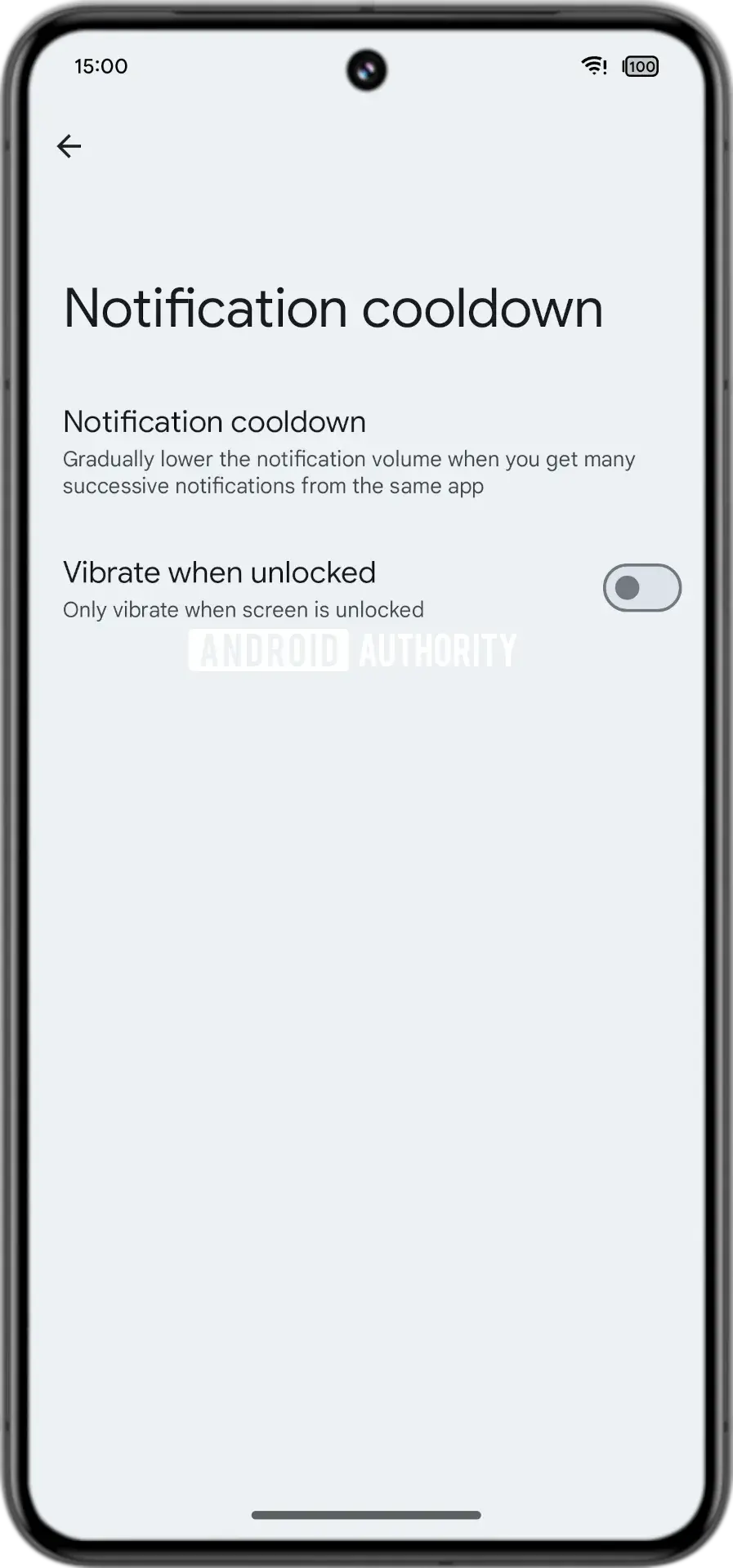The ever-growing number of notifications on our smartphones can be overwhelming, disrupting our focus and creating unwanted noise. In response, Android 15 introduces a innovative feature called Notification Cooldown, designed to improve notification management and user experience.
Android 15’s Notification Cooldown: Quieting the Notification Storm with Granular Control

Understanding Notification Cooldown
Notification Cooldown, as its name suggests, implements a cooldown period for notifications from the same app. When enabled (which is the default setting), subsequent notifications from an app will gradually decrease in volume. This aims to reduce the jarring effect of a barrage of notifications, particularly from chatty group conversations or news apps with frequent updates.
Imagine a scenario where you’re in a meeting and suddenly your phone explodes with notifications from a group chat. Notification Cooldown ensures that after the initial notification arrives at full volume, the subsequent ones become progressively quieter, minimizing disruptions.
Addressing the Vibration Issue
While Notification Cooldown effectively tackles notification volume, it initially lacked control over vibration. This meant that even with quieter sounds, the phone would still vibrate for every notification, potentially negating the intended serenity.
The Rise of “Vibrate When Unlocked”
Google, however, has a solution in the works. Recent discoveries in the Android 15 Beta 1.2 update by Mishaal Rahman, an Android Authority journalist, reveal a new option within the Notification Cooldown settings: “Vibrate when unlocked.”
This aptly named toggle offers granular control over notification vibration. With this option enabled, the phone will only vibrate for notifications when the screen is unlocked. This effectively prevents the phone from turning into a buzzing sensation in your pocket or bag when bombarded with notifications.
Customization and User Choice
The “Vibrate when unlocked” feature, unlike the core Notification Cooldown, is disabled by default. This empowers users to tailor their notification experience to their preferences. If staying discreetly informed is a priority, users can activate the toggle to prevent unwanted vibrations when the phone is locked.
However, users who prioritize not missing any notifications, even the less urgent ones, can choose to leave both Notification Cooldown and vibration entirely disabled.
Beyond Volume: Targeting Specific Notification Types
The current implementation of Notification Cooldown applies the cooldown effect to all notifications. But for users who value real-time updates for certain apps, there’s an option to refine the cooldown behavior. By adjusting the settings, users can restrict Notification Cooldown to apply only to “conversations,” effectively targeting chat apps and minimizing distractions during discussions.
The Uncertain Future of “Vibrate when Unlocked”
While the “Vibrate when unlocked” option appeared in the Android 15 Beta 1.2 update, its future remains uncertain. Google temporarily removed the user settings page in the Beta 1 update, raising concerns about the feature’s potential removal. However, its presence in the developer preview suggests its potential return in future beta versions, possibly even with further improvements.
A Promising Step Towards Notification Zen
The introduction of Notification Cooldown and the potential addition of “Vibrate when unlocked” represent a significant step forward in Android’s notification management. By offering users granular control over both notification volume and vibration behavior, these features empower users to create a less disruptive and more personalized notification experience. Whether these features become permanent fixtures in the final release of Android 15 remains to be seen, but their presence signifies Google’s commitment to improving user experience by addressing notification overload.
Additional Considerations
This article has focused on the core functionalities of Notification Cooldown and “Vibrate when unlocked.” However, it’s important to acknowledge the potential impact on accessibility. Users who rely on notification vibrations for important alerts may need to adjust their settings to ensure they don’t miss crucial information.
Furthermore, the effectiveness of Notification Cooldown might vary depending on individual preferences and notification settings within specific apps. Users may need to experiment with different configurations to find the optimal balance between staying informed and avoiding distractions. Finally, future iterations of Android could potentially offer even more granular control over notification behavior, allowing users to further customize their notification experience.
Beyond the Basics: Exploring Advanced Notification Management in Android 15

While Notification Cooldown and “Vibrate when unlocked” represent significant advancements, Android 15 offers additional features that empower users to manage their notification ecosystem effectively. Here’s a deeper dive into some of these functionalities:
1. Notification Channels:
Notification channels, introduced in Android 8.0 (Oreo), allow app developers to categorize notifications within their apps. This empowers users to prioritize and customize notification behavior on a more granular level. For example, within a social media app, users could choose to receive notification sounds for direct messages but silence notifications for general news updates.
2. Notification Snoozing:
Android 15 refines the existing notification snooze functionality, allowing users to temporarily silence notifications for a predetermined period. This can be particularly useful when focusing on a particular task or wanting a brief respite from notification overload. Users can access the snooze option by swiping left on a notification and selecting a desired snooze duration.
3. App-Specific Notification Settings:
Building upon Notification Channels, Android 15 allows users to access and modify notification settings directly from the notification itself. This eliminates the need to delve deep into app settings menus. By tapping and holding on a notification, users can access a menu that allows them to customize notification behavior for that specific app, including notification sounds, vibration patterns, and even the ability to completely silence notifications for that app.
4. Priority Mode Enhancements:
Priority mode, a longstanding feature in Android, allows users to create custom notification profiles for different scenarios. Android 15 offers potential refinements to priority mode, allowing users to define even more granular control over notification behavior based on time, location, or specific contacts. For example, users could create a “Work Focus” priority mode that silences all notifications except for urgent calls and messages from work contacts during working hours.
The Importance of User Education and Awareness
While Android 15 offers a plethora of notification management tools, many users might not be fully aware of the available options. Here’s how manufacturers and app developers can contribute to a more informed user experience:
- Pre-installed Tutorials: Manufacturers can include short, in-app tutorials within the Settings menu that highlight the new notification management features and their functionalities.
- In-App Guidance: App developers can implement contextual hints or tooltips within their apps to guide users towards notification channel settings, allowing them to personalize their notification experience.
- User-Friendly Interfaces: Clear and intuitive interfaces within the Settings menu and notification options are crucial for maximizing user adoption and understanding of the available notification management tools.
The Future of Notification Management in Android
The introduction of Notification Cooldown and the potential addition of “Vibrate when unlocked” demonstrate Google‘s commitment to improving user experience by addressing notification overload. Here are some potential areas for future exploration:
- Machine Learning-powered Notification Filtering: Leveraging machine learning algorithms, Android could potentially analyze user behavior and notification preferences to automatically prioritize and filter notifications, ensuring that only the most relevant and timely alerts reach users.
- Context-Aware Notification Delivery: Building upon location and activity detection, future versions of Android could tailor notification delivery based on context. For example, notifications might be silenced or displayed differently during meetings, while driving, or while sleeping.
- Improved App Developer Guidance: Google can provide more comprehensive guidelines and best practices for app developers regarding notification implementation. Standardized notification formats and clear user controls within apps can further enhance the overall notification management experience.
By continuing to innovate and refine notification management features, Android strives to empower users to take control of their digital well-being and create a more serene and focused mobile experience.





